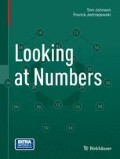Abstract
One combinatorial design that has particularly interested me is (9,4,3). With only nine numbers, and only 36 pairs of numbers, the system is small enough that one should be able to see how it works, and since by definition each pair occurs three times in three different blocks of four, all that is necessary is to write out the 36 pairs and connect each pair with the three other pairs that form one of the 18 blocks of the system. I could imagine all these three-armed pairs holding hands with one another in lovely triangular lattices, and since the Handbook of Combinatorial Design gives 11 completely different solutions to work with, I was sure that clearly spaced drawings would allow us to look inside each system and see how it all connects. I could imagine 11 drawings, all different, and all containing lovely symmetries.
Access this chapter
Tax calculation will be finalised at checkout
Purchases are for personal use only
References
Colbourn, C., and J. Dinitz. 2007. Handbook of Combinatorial Designs. Boca Raton: CRC Press.
Further Reading
Breach, D.R. 1979. The 2-(9,4,3) and 3-(10,5,3) designs. Journal of Combinatorial Theory Series A 27:50–63.
Butler, G. 1991. Fundamental Algorithms for Permutations Groups. Berlin: Springer.
Hoffmann, C.M. 1982. Group-Theoretic Algorithms and Graph Isomorphism. Berlin: Springer.
Seress, A. 2003. Permutation Group Algorithms. Cambridge: Cambridge University Press.
Stanton, R.G., R.C. Mullin, and J.A. Bate. 1976. Isomorphism classes of a set of prime BIBD parameters. Ars Combinatoria 2:251–264.
Author information
Authors and Affiliations
Corresponding author
Rights and permissions
Copyright information
© 2014 Springer Basel
About this chapter
Cite this chapter
Johnson, T., Jedrzejewski, F. (2014). (9,4,3). In: Looking at Numbers. Birkhäuser, Basel. https://doi.org/10.1007/978-3-0348-0554-4_6
Download citation
DOI: https://doi.org/10.1007/978-3-0348-0554-4_6
Published:
Publisher Name: Birkhäuser, Basel
Print ISBN: 978-3-0348-0553-7
Online ISBN: 978-3-0348-0554-4
eBook Packages: Mathematics and StatisticsMathematics and Statistics (R0)

